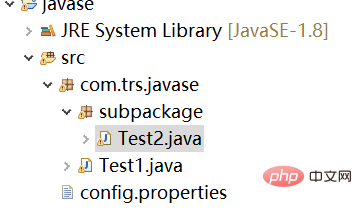Examples of the getResource() method in java

First of all, let’s introduce a concept, classpath, which refers to the directory where compiled class files, xml, properties and other configuration files are located. For example, if it is a maven project, the classpath is "project name/target/classes". If it is a normal project, it may be "project name/bin", or "project name/build/classes", etc.
getResource is a method of java.lang.Class, which is called by the bytecode object.
(Recommended tutorial: java introductory program)
getResource accepts a string parameter. If it starts with "/", it will be found in the root directory of the classpath (no Search subdirectories recursively), if it does not start with "/", search in the directory where the bytecode object that calls getResource is located (the subdirectory will not be searched recursively).
Example:

@Test
public void test() {
System.out.println(Test1.class.getResource(""));
System.out.println(Test1.class.getResource("/"));
System.out.println(Test1.class.getResource("Test1.class"));
System.out.println(Test1.class.getResource("/Test1.class"));
}The first sentence, Test1 is under com.trs.javase, so "xxx.com.trs.javase" will be output. If it is called by Test2.class, "xxx.com.trs.javase.subpackage" will be output.
The second sentence will output the root directory of the classpath.
The third sentence will output the directory where Test1.class is located.
The fourth sentence, Test1.class is not in the root directory of the classpath, so null will be output.
Output result:
file:/D:/eclipse-workspace/javase/bin/com/trs/javase/ file:/D:/eclipse-workspace/javase/bin/ file:/D:/eclipse-workspace/javase/bin/com/trs/javase/Test1.class null
(Video tutorial recommendation: java video tutorial)
The above is the detailed content of Examples of the getResource() method in java. For more information, please follow other related articles on the PHP Chinese website!

Hot AI Tools

Undresser.AI Undress
AI-powered app for creating realistic nude photos

AI Clothes Remover
Online AI tool for removing clothes from photos.

Undress AI Tool
Undress images for free

Clothoff.io
AI clothes remover

AI Hentai Generator
Generate AI Hentai for free.

Hot Article

Hot Tools

Notepad++7.3.1
Easy-to-use and free code editor

SublimeText3 Chinese version
Chinese version, very easy to use

Zend Studio 13.0.1
Powerful PHP integrated development environment

Dreamweaver CS6
Visual web development tools

SublimeText3 Mac version
God-level code editing software (SublimeText3)

Hot Topics
 Square Root in Java
Aug 30, 2024 pm 04:26 PM
Square Root in Java
Aug 30, 2024 pm 04:26 PM
Guide to Square Root in Java. Here we discuss how Square Root works in Java with example and its code implementation respectively.
 Perfect Number in Java
Aug 30, 2024 pm 04:28 PM
Perfect Number in Java
Aug 30, 2024 pm 04:28 PM
Guide to Perfect Number in Java. Here we discuss the Definition, How to check Perfect number in Java?, examples with code implementation.
 Random Number Generator in Java
Aug 30, 2024 pm 04:27 PM
Random Number Generator in Java
Aug 30, 2024 pm 04:27 PM
Guide to Random Number Generator in Java. Here we discuss Functions in Java with examples and two different Generators with ther examples.
 Weka in Java
Aug 30, 2024 pm 04:28 PM
Weka in Java
Aug 30, 2024 pm 04:28 PM
Guide to Weka in Java. Here we discuss the Introduction, how to use weka java, the type of platform, and advantages with examples.
 Armstrong Number in Java
Aug 30, 2024 pm 04:26 PM
Armstrong Number in Java
Aug 30, 2024 pm 04:26 PM
Guide to the Armstrong Number in Java. Here we discuss an introduction to Armstrong's number in java along with some of the code.
 Smith Number in Java
Aug 30, 2024 pm 04:28 PM
Smith Number in Java
Aug 30, 2024 pm 04:28 PM
Guide to Smith Number in Java. Here we discuss the Definition, How to check smith number in Java? example with code implementation.
 Java Spring Interview Questions
Aug 30, 2024 pm 04:29 PM
Java Spring Interview Questions
Aug 30, 2024 pm 04:29 PM
In this article, we have kept the most asked Java Spring Interview Questions with their detailed answers. So that you can crack the interview.
 Break or return from Java 8 stream forEach?
Feb 07, 2025 pm 12:09 PM
Break or return from Java 8 stream forEach?
Feb 07, 2025 pm 12:09 PM
Java 8 introduces the Stream API, providing a powerful and expressive way to process data collections. However, a common question when using Stream is: How to break or return from a forEach operation? Traditional loops allow for early interruption or return, but Stream's forEach method does not directly support this method. This article will explain the reasons and explore alternative methods for implementing premature termination in Stream processing systems. Further reading: Java Stream API improvements Understand Stream forEach The forEach method is a terminal operation that performs one operation on each element in the Stream. Its design intention is






